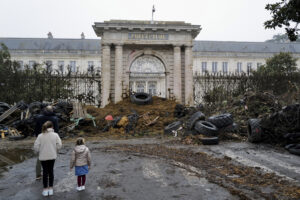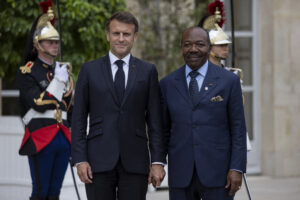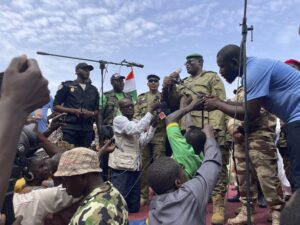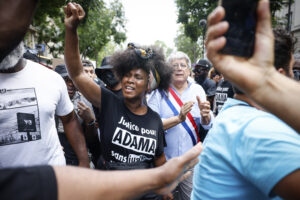Horrors of War Our Leaders Never Have to Confront
I'm not sure of this, but I think -- I suspect and feel -- that the Great War, the war of 1914-1918, is beginning to dominate our lives even more than the terrible and infinitely more costly conflict of 1939-1945. The Second World War may haunt our lives. The First World War, it seems to me, imprisons us all.Editor’s Note: This article was originally printed in The Independent on Sept. 13.
Just outside Andrew Holden’s office at the Christchurch Press off Cathedral Square – and, believe me, New Zealand’s prettiest city is as colonial as they come, a Potemkin town of mock-Tudor government buildings, Scottish baronial churches and wooden versions of Victorian homes – is a brightly coloured, cheerful little water-colour. Boarding a big steamship, thousands of New Zealanders in big broad-bottomed brown hats are lining the quaysides, the gangplanks and the decks.
For a moment this week, I thought this might be some annual festival (perhaps involving New Zealand’s 35 million boring sheep). But then Andrew spotted my interest. “They’re going to Gallipoli,” he said. And – fast as the lightning bolt of history – my eyes returned to the tiny figures on the deck. Off they were going, another flower of youth, to the trenches and dust and filth of my father’s war.
I’m not sure of this, but I think – I suspect and feel – that the Great War, the war of 1914-1918, is beginning to dominate our lives even more than the terrible and infinitely more costly conflict of 1939-1945. As the years go by, the visitors to the great cemeteries of the Somme, Passchendaele and Verdun grow greater in number. The Second World War may haunt our lives. The First World War, it seems to me, imprisons us all.
The statistics still have the power to overawe us. As John Terraine calculates, by November of 1918, France had lost 1,700,000 men out of a population of 40 million, the British Empire a million – 700,000 of them from the 50 million people of the British Isles. The British Army, let it be repeated, lost 20,000 killed on the first day of the Somme. I noticed that in Christchurch Cathedral, the bronze plaques to the Great War dead had been newly polished – so that they looked as they must have been seen by those who came to mourn almost a hundred years ago.
Who would have believed, even half a century ago, that this year’s Toronto Film Festival would open in Canada with a film called Passchendaele – perhaps the most-difficult-to-spell-movie of all time – the film poster showing just a young man standing in mud and filth and rain? Who could conceive that one of the most popular non-fiction books in recent Canadian history would be the Ottawa War Museum’s Great War historian Tim Cook’s At the Sharp End, the first volume of his monumental study of Canadians in the 1914-18 war?
Canada had its Douglas Haig – a maniac called Sam Hughes (“Minister of Militia and Defence”) who forced his young men to use the hopeless Canadian-made Mark III Ross rifle which jammed and misfired and heaped up the corpses of Canadians who could not defend themselves with this patriotic, murderous weapon. Cook, despite his occasional tendency to cliché (says Fisk) is superlative.
His description of desperately young Canadian men cowering in shell-holes – showered by the putrefying remains of their long-dead friends as bodies are again torn apart by shells – is devastating. So, too, are his quotations from the letters home of Canadian soldiers. “I went thru all the fights the same as if I was making logs,” Sergeant Frank Maheux writes home to his wife in an innocent, broken English. “I bayoneted some (sic) killed lots of Huns. I was caught in one place with a chum of mine he was killed beside me when I saw he was killed I saw red … The Germans when they saw they were beaten they put up their hands but dear wife it was too late.”
My God, how that “dear wife” tells the truth about the surrendering Germans’ fate. And here is Captain Joseph Chabelle of the Canadian 2nd Division’s 22 Battalion: “Oh! The sensation of driving the blade into flesh, between the ribs, despite the opponent’s grasping efforts to deflect it. You struggle savagely, panting furiously, lips contorted in a grimace, teeth gnashing, until you feel the enemy relax his grip and topple like a log. To remove the bayonet, you have to pull it out with both hands; if it is caught in the bone, you must brace your foot on the still heaving body, and tug with all your might.”
Private James Owen was to describe how an enraged friend was trying to bayonet another German. “He lunged at the German again and again, who each time lowered his arms and stopped the point of the bayonet with his bare hands. He was screaming for mercy. Oh God it was brutal!”
Haig, by the way, was initially dismissive of the Canadians. “They have been very extravagant in expending ammunition!” he complained. “This points rather to nervousness and low morale.”
How the gorge rises at such wickedness. But it rises far more as you turn the pages of the beautifully produced, desperate collection of French soldiers’ amateur paintings and sketches of the Great War – “Croquis et dessins de Poilus” – which, ironically, includes a set of sad portraits of the poilus’ Canadian comrades. This magnificent book was produced by the French Ministry of Defence; why it could not have had a joint production with the Imperial War Museum beggars belief – does the Entente now count for nothing? For anyone who wants to understand the total failure of the human spirit which war represents – and the utter disgust which must follow the “arbitrament”of war (a Chamberlain word this – see his 3 September 1939, declaration of war) – must read the extract from Jean Giono’s Le Grand Troupeau, which accompanies Louis Dauphin’s bleak, rainswept painting, “Supply Route at Peronne”.
“The rats, with red eyes, march delicately along the trench,” Giono writes of the creatures with whom he shared the war. “All life had disappeared down there except for that of the rats and the lice … The rats were coming to sniff the bodies … They chose the young men without beards on the cheeks … rolled up into a ball and began to eat the flesh between the nose and the mouth up to the edge of the lips … from time to time they would wash their whiskers to stay clean. Then the eyes, they took them out with their claws, licked the eyelids, and would then bite into the eye as if it was a small egg …”
My father saw these horrors on the Somme. They all did. Of course, Messrs Bush and Blair did not have to soil their thoughts with such images. Our boys shipping off to war – Mrs Thatcher happily endured the Gallipoli-like departures from Portsmouth – is enough for our leaders. But could it be, perhaps, that we – the people – know more about horror than our masters? Our history suggests this is true.
Your support matters…Independent journalism is under threat and overshadowed by heavily funded mainstream media.
You can help level the playing field. Become a member.
Your tax-deductible contribution keeps us digging beneath the headlines to give you thought-provoking, investigative reporting and analysis that unearths what's really happening- without compromise.
Give today to support our courageous, independent journalists.





You need to be a supporter to comment.
There are currently no responses to this article.
Be the first to respond.